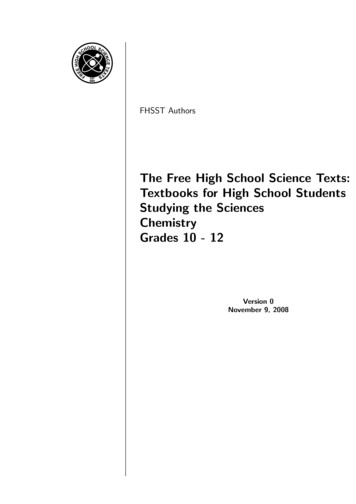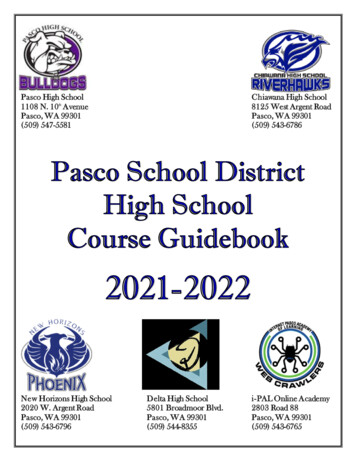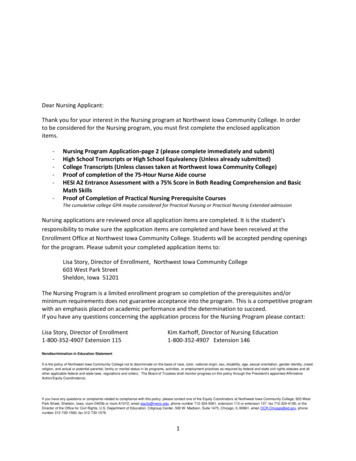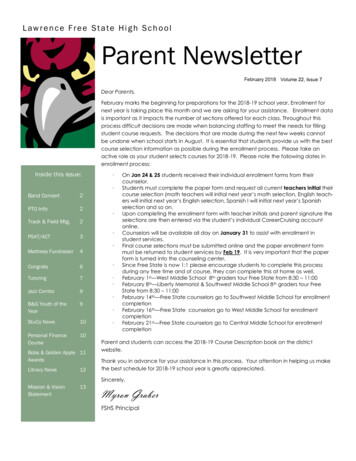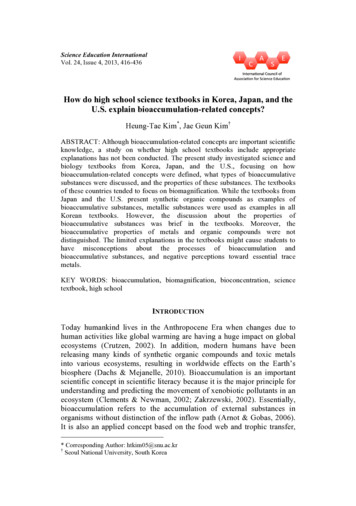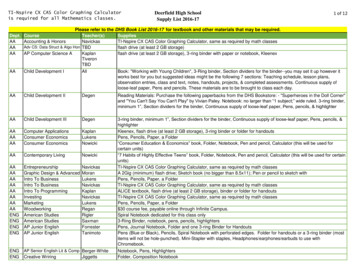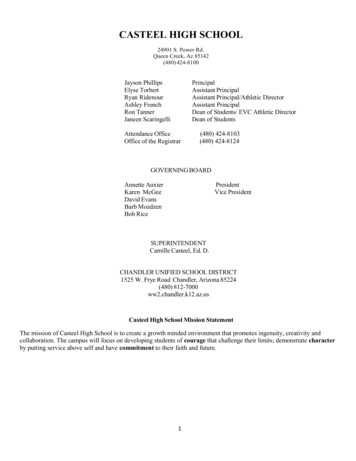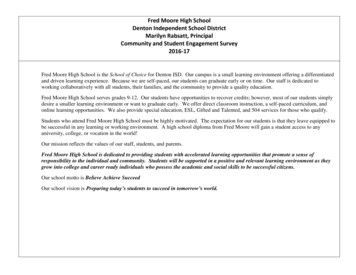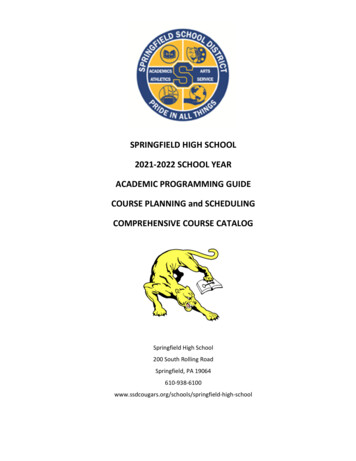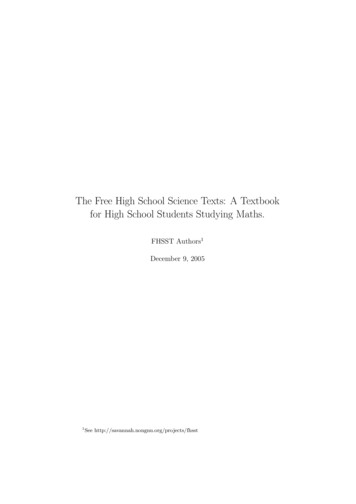
Transcription
The Free High School Science Texts: A Textbookfor High School Students Studying Maths.FHSST Authors1December 9, 20051See http://savannah.nongnu.org/projects/fhsst
c 2003 “Free High School Science Texts”Copyright Permission is granted to copy, distribute and/or modify this document under the terms of the GNU Free Documentation License, Version 1.2 or any later version published by the Free Software Foundation; with no Invariant Sections, no Front-Cover Texts, and noBack-Cover Texts. A copy of the license is included in the sectionentitled “GNU Free Documentation License”.i
ContentsIMaths11 Numbers1.1 Letters and Arithmetic . . . . . . . . . .1.1.1 Adding and Subtracting . . . . .1.1.2 Negative Numbers . . . . . . . .1.1.3 Brackets . . . . . . . . . . . . . .1.1.4 Multiplying and Dividing . . . .1.1.5 Rearranging Equations . . . . . .1.1.6 Living Without the Number Line1.2 Types of Real Numbers . . . . . . . . .1.2.1 Integers . . . . . . . . . . . . . .1.2.2 Fractions and Decimal numbers .1.2.3 Rational Numbers . . . . . . . .1.3 Exponents . . . . . . . . . . . . . . . . .1.4 Surds . . . . . . . . . . . . . . . . . . .1.4.1 Like and Unlike Surds . . . . . .1.4.2 Rationalising Denominators . . .1.4.3 Estimating a Surd . . . . . . . .1.5 Accuracy . . . . . . . . . . . . . . . . .1.5.1 Scientific Notation . . . . . . . .1.5.2 Worked Examples . . . . . . . .1.5.3 Exercises . . . . . . . . . . . . .34456678999101416171818192020212 Patterns in Numbers2.1 Sequences . . . . . . . . . . . . . . . . . .2.1.1 Arithmetic Sequences . . . . . . .2.1.2 Quadratic Sequences . . . . . . . .2.1.3 Geometric Sequences . . . . . . . .2.1.4 Recursive Equations for sequences2.1.5 Extra . . . . . . . . . . . . . . . .2.2 Series (Grade 12) . . . . . . . . . . . . . .2.2.1 Finite Arithmetic Series . . . . . .2.2.2 Finite Squared Series . . . . . . . .2.2.3 Finite Geometric Series . . . . . .2.2.4 Infinite Series . . . . . . . . . . . .2.3 Worked Examples . . . . . . . . . . . . .2.4 Exercises . . . . . . . . . . . . . . . . . .2222232526272828293232333336ii
3 Functions3.1 Functions and Graphs . . . . . . . . . . .3.1.1 Variables, Constants and Relations3.1.2 Definition of a Function (grade 12)3.1.3 Domain and Range of a Relation .3.1.4 Example Functions . . . . . . . . .3.2 Exponentials and Logarithms . . . . . . .3.2.1 Exponential Functions . . . . . . .3.2.2 Logarithmic Functions . . . . . . .3.3 Extra . . . . . . . . . . . . . . . . . . . .3.3.1 Absolute Value Functions . . . . .4 Numerics4.1 Optimisation . . . . . . . . . . . . . . . . . . .4.1.1 Linear Programming . . . . . . . . . . .4.2 Gradient . . . . . . . . . . . . . . . . . . . . . .4.3 Old Content (please delete when finished) . . .4.3.1 Problems . . . . . . . . . . . . . . . . .4.3.2 Maximising or Minimising the Objective.3838394041424647474949. . . . . . . . . . . . . . . . . . . . . . . . . .Function.53535557575759.Essay 1 : Differentiation in the Financial World5 Differentiation5.1 Limit and Derivative . . . . . . . .5.1.1 Gradients and limits . . . .5.1.2 Differentiating f (x) xn .5.1.3 Other notations . . . . . . .5.2 Rules of Differentiation . . . . . .5.2.1 Summary . . . . . . . . . .5.3 Using Differentiation with Graphs5.3.1 Finding Tangent Lines . . .5.3.2 Curve Sketching . . . . . .5.4 Worked Examples . . . . . . . . .5.5 Exercises . . . . . . . . . . . . . .6 Geometry6.1 Polygons . . . . . . . . . . . . . . . . . . .6.1.1 Triangles . . . . . . . . . . . . . .6.1.2 Quadrilaterals . . . . . . . . . . .6.1.3 Other polygons . . . . . . . . . . .6.1.4 Similarity of Polygons . . . . . . .6.1.5 Midpoint Theorem . . . . . . . . .6.1.6 Extra . . . . . . . . . . . . . . . .6.2 Solids . . . . . . . . . . . . . . . . . . . .6.3 Coordinates . . . . . . . . . . . . . . . . .6.4 Transformations . . . . . . . . . . . . . .6.4.1 Shifting, Reflecting, Stretching and6.5 Stretching and Shrinking Graphs . . . . .6.6 Mixed Problems . . . . . . . . . . . . . .6.7 Equation of a Line . . . . . . . . . . . . .iii62.646464666767686868696974. . . . . . . . . . . . . . . . . . . . . . . . . . . . . . . . . . . . . . . . . . . . . . . . . . . . . . . . . . . . . . . . . . . . . . . . . . . . . . . . . . . . . . . . . . . . . . . . . . . . .Shrinking Graphs:. . . . . . . . . . . . . . . . . . . . . . . . . . . . . . .767677787979798081828282848686.
6.8Circles . . . . . . . . . . . . . . . . . . . . . . . . .6.8.1 Circles & Semi-circles . . . . . . . . . . . .6.9 Locus . . . . . . . . . . . . . . . . . . . . . . . . .6.10 Other Geometries . . . . . . . . . . . . . . . . . . .6.11 Unsorted . . . . . . . . . . . . . . . . . . . . . . .6.11.1 Fundamental vocabulary terms . . . . . . .6.11.2 Parallel lines intersected by transversal lines.878788888888917 Trigonometry7.1 Syllabus . . . . . . . . . . . . . . . . . . . . . . . . . . . . . .7.1.1 Triangles . . . . . . . . . . . . . . . . . . . . . . . . .7.1.2 Trigonometric Formulæ . . . . . . . . . . . . . . . . .7.2 Radian and Degree Measure . . . . . . . . . . . . . . . . . . .7.2.1 The unit of radians . . . . . . . . . . . . . . . . . . . .7.3 Definition of the Trigonometric Functions . . . . . . . . . . .7.3.1 Trigonometry of a Right Angled Triangle . . . . . . .7.3.2 Trigonometric Graphs . . . . . . . . . . . . . . . . . .7.3.3 Secant, Cosecant, Cotangent and their graphs . . . . .7.3.4 Inverse trigonometric functions . . . . . . . . . . . . .7.4 Trigonometric Rules and Identities . . . . . . . . . . . . . . .7.4.1 Translation and Reflection . . . . . . . . . . . . . . . .7.4.2 Pythagorean Identities . . . . . . . . . . . . . . . . . .7.4.3 Sine Rule . . . . . . . . . . . . . . . . . . . . . . . . .7.4.4 Cosine Rule . . . . . . . . . . . . . . . . . . . . . . . .7.4.5 Area Rule . . . . . . . . . . . . . . . . . . . . . . . . .7.4.6 Addition and Subtraction Formulae . . . . . . . . . .7.4.7 Double and Triple Angle Formulae . . . . . . . . . . .7.4.8 Half Angle Formulae . . . . . . . . . . . . . . . . . . .7.4.9 ‘Product to Sum’ and ‘Sum to Product’ Identities . .7.4.10 Solving Trigonometric Identities . . . . . . . . . . . .7.5 Application of Trigonometry . . . . . . . . . . . . . . . . . . .7.5.1 Height and Depth . . . . . . . . . . . . . . . . . . . .7.5.2 Maps and Plans . . . . . . . . . . . . . . . . . . . . .7.6 Trigonometric Equations . . . . . . . . . . . . . . . . . . . . .7.6.1 Solution using CAST diagrams . . . . . . . . . . . . .7.6.2 Solution Using Periodicity . . . . . . . . . . . . . . . .7.6.3 Linear Triginometric Equations . . . . . . . . . . . . .7.6.4 Quadratic and Higher Order Trigonometric Equations7.6.5 More Complex Trigonometric Equations . . . . . . . .7.7 Summary of the Trigonomertic Rules and Identities . . . . . 1161171171181181191201221251261261271288 Solving Equations8.1 Linear Equations . . . . . . . . . . . . . . . . . . . . . . . .8.1.1 Introduction . . . . . . . . . . . . . . . . . . . . . .8.1.2 Solving Linear equations - the basics . . . . . . . . .8.1.3 Solving linear equations - Combining the basics in asteps . . . . . . . . . . . . . . . . . . . . . . . . . . .8.2 Quadratic Equations . . . . . . . . . . . . . . . . . . . . . .8.2.1 The Quadratic Function . . . . . . . . . . . . . . . .iv. . . . . . .few. . . . . . .130130130131133136136
8.2.28.38.48.58.68.78.8Writing a quadratic function in the formp)2 q. . . . . . . . . . . . . . . . . . . .8.2.3 What is a Quadratic Equation? . . . . . .8.2.4 Factorisation . . . . . . . . . . . . . . . .8.2.5 Completing the Square . . . . . . . . . . .8.2.6 Theory of Quadratic Equations . . . . . .Cubic Equations . . . . . . . . . . . . . . . . . .Exponential Equations . . . . . . . . . . . . . . .Trigonometric Equations . . . . . . . . . . . . . .Simultaneous Equations . . . . . . . . . . . . . .Inequalities . . . . . . . . . . . . . . . . . . . . .8.7.1 Linear Inequalities . . . . . . . . . . . . .8.7.2 What is a Quadratic Inequality . . . . . .8.7.3 Solving Quadratic Inequalities . . . . . .Intersections . . . . . . . . . . . . . . . . . . . . .9 Working with Data9.1 Statistics . . . . . . .9.2 Function Fitting . . .9.3 Probability . . . . . .9.4 Permutations and Tree9.5 Finance . . . . . . . .9.6 Worked Examples . .9.7 Exercises . . . . . . .II. . . . . . . . . . . . . . . .Diagrams. . . . . . . . . . . . . . . .f (x). . . . . . . . . . . . . . . . . . . . . . . . . . . . . a(x . . . . . . . . . . . . . . . . . . . . . . . . . . . . . . . . . . . . . . . . . . . . . . . . . . . . . . . . . . . . . . . . . . . . . . 152153153154154154.Old Maths10 Worked Examples10.1 Exponential Numbers . .10.2 series . . . . . . . . . . . .10.3 functions . . . . . . . . .10.3.1 Worked Examples:155.A GNU Free Documentation Licensev.156156166170186188
Part IMaths1
This book attempts to meet the criteria for the SA “Outcomes Based” syllabus of 2004. A few notes to authors:All “real world examples” should be in the context of HIV/AIDS, labourdisputes, human rights, social, economical, cultural, political and environmentalissues. Unless otherwise stated in the syllabus. Where possible, every sectionshould have a practical problem.The preferred method for disproving something is by counter example. Justification for any mathematical generalisations of applied examples is alwaysdesired.2
Chapter 1Numbers(NOTE: more examples and motivation needed. perhaps drop the proofs forexponents and surds?)A number is a way to represent quantity. Numbers are not something thatwe can touch or hold, because they are not physical. But you can touch threeapples, three pencils, three books. You can never just touch three, you can onlytouch three of something. However, you don’t need to see three apples in frontof you to know that if you take one apple away, that there will be two applesleft. You can just think about it. That is your brain representing the apples innumbers and then performing arithmetic on them.A number represents quantity because we can look at the world around usand quantify it using numbers. How many minutes? How many kilometers?How many apples? How much money? How much medicine? These are allquestions which can only be answered using numbers to tell us “how much” ofsomething we want to measure.A number can be written many different ways and it is always best to choosethe most appropriate way of writing the number. For example, the number “ahalf” may be spoken aloud or written in words, but that makes mathematicsvery difficult and also means that only people who speak the same language asyou can understand what you mean. A better way of writing “a half” is as afraction 12 or as a decimal number 0,5. It is still the same number, no matterwhich way you write it.In high school, all the numbers which you will see are called real numbers(NOTE: Advanced: The name “real numbers” is used because there aredifferent and more complicated numbers known as “imaginary numbers”, whichthis book will not go into. Since we won’t be looking at numbers which aren’treal, if you see a number you can be sure it is a real one.) and mathematiciansuse the symbol R to stand for the set of all real numbers, which simply means allof the real numbers. Some of these real numbers can be written in a particularway, but others cannot.This chapter will explain different ways of writing any number, and wheneach way of writing the number is best.(NOTE: This intro needs more motivation for different types of numbers,some real world examples and more interesting facts. Lets avoid the wholedifferent numeral systems though. maybe when we do the history edit nearrelease.)3
1.1Letters and ArithmeticThe syllabus requires: algebraic manipulation is governed by the algebra of the realnumbers manipulate equations (rearrange for y, expand a squared bracket)(NOTE: “algebra of the Reals”. why letters are useful. very simple example, like change from a shop. brackets, squared brackets, fractions, multiply topand bottom. rearranging. doing something to one side and the other.)When you add, subtract, multiply or divide two numbers, you are performingarithmetic 1 . These four basic operations ( , , , ) can be performed on anytwo real numbers.Since they work for any two real numbers, it would take forever to write outevery possible combination, since there are an infinite(NOTE: Advanced: wereally need to define what infinite means, nicely!) amount of real numbers! Tomake things easier, it is convenient to use letters to stand in for any number 2 ,and then we can fill in a particular number when we need to. For example, thefollowing equationx y z(1.1)can find the change you are owed for buying an item. In this equation, xrepresents the amount of ch
This book attempts to meet the criteria for the SA \Outcomes Based" syl-labus of 2004. A few notes to authors: All \real world examples" should be in the context of HIV/AIDS, labour
